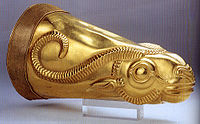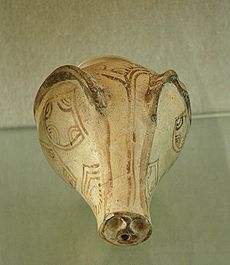
Rhyton
Encyclopedia

Libation
A libation is a ritual pouring of a liquid as an offering to a god or spirit or in memory of those who have died. It was common in many religions of antiquity and continues to be offered in various cultures today....
. Rhytons were very common in ancient Persia, where they were called takuk (تکوک). The English word rhyton originates in the ancient Greek
Greek language
Greek is an independent branch of the Indo-European family of languages. Native to the southern Balkans, it has the longest documented history of any Indo-European language, spanning 34 centuries of written records. Its writing system has been the Greek alphabet for the majority of its history;...
word ῥυτόν (rhŭtón).
After a Greek victory against Persia, much silver, gold, and other luxuries, including numerous rhytons, were brought to Athens. Persian rhytons were immediately imitated by Greek artists.
Name and function

Proto-Indo-European language
The Proto-Indo-European language is the reconstructed common ancestor of the Indo-European languages, spoken by the Proto-Indo-Europeans...
*sreu-, "flow", and would thereby mean "pourer". Many vessels considered rhytons featured a wide mouth at the top and a hole through a conical constriction at the bottom from which the fluid ran. The idea is that one scooped wine or water from a storage vessel or similar source, held it up, unstoppered the hole with one's thumb, and let the fluid run into the mouth (or onto the ground in libation
Libation
A libation is a ritual pouring of a liquid as an offering to a god or spirit or in memory of those who have died. It was common in many religions of antiquity and continues to be offered in various cultures today....
) in the same way wine is drunk from a wineskin today.
Smith points out that this use is testified in classical paintings and accepts Athenaeus
Athenaeus
Athenaeus , of Naucratis in Egypt, Greek rhetorician and grammarian, flourished about the end of the 2nd and beginning of the 3rd century AD...
's etymology that it was named apo tes rhyseos, "from the flowing". Smith also categorized the name as having been a recent form (in classical times) of a vessel formerly called the keras, "horn", in the sense of a drinking horn. The word rhyton is not present in what is known of the oldest form of Greek, Mycenaean Greek, written in Linear B
Linear B
Linear B is a syllabic script that was used for writing Mycenaean Greek, an early form of Greek. It pre-dated the Greek alphabet by several centuries and seems to have died out with the fall of Mycenaean civilization...
, but the bull's head rhyton, of which many examples survive, is mentioned in the inventory of vessels at Knossos
Knossos
Knossos , also known as Labyrinth, or Knossos Palace, is the largest Bronze Age archaeological site on Crete and probably the ceremonial and political centre of the Minoan civilization and culture. The palace appears as a maze of workrooms, living spaces, and store rooms close to a central square...
, such as tablet 231 (K872), as ke-ra-a, shown with the bull ideogram. The word is restored as an adjective, *kera(h)a, with Mycenaean intervocalic h.
Wide provenance

Rhyta occur among the remains of civilizations speaking different languages and language groups in and around the Near and Middle East, such as Persia from the second millennium BC onwards. They are often shaped like an animal head or horn and can be very ornate and compounded with precious metals and stones. In Minoan Crete
Minoan civilization
The Minoan civilization was a Bronze Age civilization that arose on the island of Crete and flourished from approximately the 27th century BC to the 15th century BC. It was rediscovered at the beginning of the 20th century through the work of the British archaeologist Arthur Evans...
, silver and gold bulls' heads with round openings for the wine (permitting wine to pour from the bull's mouth) seemed particularly common, for several have been recovered from the great palaces (Iraklion Archaeological Museum
Iraklion Archaeological Museum
The Heraklion Archaeological Museum is a museum located in Heraklion on Crete. It is one the great museums of Greece and the best in the world for Minoan art, as it contains the most notable and complete collection of artifacts of the Minoan civilization of Crete. The museum began in 1883 as a...
).

Greek symbolism
Classical Athenian pottery, such as red-figure vases, are decorated with painted themes typically from mythology. One standard theme depicts satyrs, which symbolize ribaldry, with rhyta and wineskins. The horn-shaped rhyta are carefully woven in composition with the erect male organs of the satyrs, but this blatantly sexual and somewhat humorous theme appears to be a late development, in keeping with Athenian humor, as is expressed in the plays of AristophanesAristophanes
Aristophanes , son of Philippus, of the deme Cydathenaus, was a comic playwright of ancient Athens. Eleven of his forty plays survive virtually complete...
. The ornate and precious rhyta of the great civilizations of earlier times are grandiose rather than ribald, which gives the democratic vase paintings an extra satirical dimension.
The connection of satyrs with wine and rhyta had been made earlier. In Nonnos's epic Dionysiaca, he describes the satyr
Satyr
In Greek mythology, satyrs are a troop of male companions of Pan and Dionysus — "satyresses" were a late invention of poets — that roamed the woods and mountains. In myths they are often associated with pipe-playing....
s at the first discovery of wine-making:
- "...the fruit bubbled out red juice with white foam. They scooped it up with oxhorns, instead of cups which had not yet been seen, so that ever after the cup of mixed wine took this divine name of 'Winehorn'."
Karl Kerenyi
Karl Kerényi
Károly Kerényi was a Hungarian scholar in classical philology, one of the founders of modern studies in Greek mythology.- Hungary 1897–1943 :...
, in quoting this passage, remarks, "At the core of this richly elaborated myth, in which the poet even recalls the rhyta, it is not easy to separate the Cretan elements from those originating in Asia Minor
Asia Minor
Asia Minor is a geographical location at the westernmost protrusion of Asia, also called Anatolia, and corresponds to the western two thirds of the Asian part of Turkey...
."
External links
Pictures of rhyta:- Achaemenid Persian Lion Rhyton
- Minoan Bull-head Rhyton
- Prehistoric European Rhyta
- Tibetan Rhyton
- Cretan-style Rhyton from Egypt
- Attic red-figure vase, satyr holding a rhyton
Articles on rhyta:
- Smith, Dictionary of Greek and Roman Antiquities, under "Rhyton"
- Karla Huebner, "A Minoan Vase from Zakros, Crete: The Sanctuary Rhyton", in ANISTORITON Issue P032 of 7 June 2003

